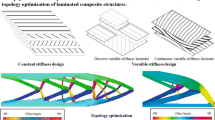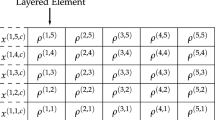Abstract
Numerical optimization is an indispensable part of the design process of laminated composite structures. Several optimality criteria-based algorithms exist which rely on a sequential resizing and scaling approach. This paper presents a novel design algorithm applicable for stiffness and eigenfrequency optimization of composite structures with concurrent consideration of resizing and scaling operations. A method is introduced that allows for an efficient consideration of nonlinear constraints. This is done by determining stable concurrent scaling parameters from first-order constraint change ratio estimations. Optimization is carried out using optimality criteria in three independent steps, namely with respect to fiber angles, ply thickness ratios, and total laminate thickness. Sensitivity analyses are performed analytically at low computational costs. Numerical examples demonstrate the efficiency and fast convergence of the method. Compared to established algorithms, the number of required function evaluations is reduced significantly.















Similar content being viewed by others
References
Abdalla MM, Setoodeh S, Gürdal Z (2007) Design of variable stiffness composite panels for maximum fundamental frequency using lamination parameters. Compos Struct 81(2):283–291
Duvaut G, Terrel G, Léné F, Verijenko V (2000) Optimization of fiber reinforced composites. Compos Struct 48(1):83–89
Fischer B, Horn B, Bartelt C, Blößl Y (2015) Method for an automated optimization of fiber patch placement layup designs. Int J Compos Math 5(2):37–46
Fukunaga H, Sekine H (1993) Optimum design of composite structures for shape, layer angle and layer thickness distributions. J Compos Mater 27(15):1479–1492
Fukunaga H, Vanderplaats G (1991) Strength optimization of laminated composites with respect to layer thickness and/or layer orientation angle. Comput Struct 40(6):1429–1439
Gallier J (2010) The schur complement and symmetric positive semidefinite (and definite) matrices. December 44:1–12
Ghiasi H, Fayazbakhsh K, Pasini D, Lessard L (2010) Optimum stacking sequence design of composite materials part ii: Variable stiffness design. Compos Struct 93(1):1–13
Grandhi R, Bharatram G, Venkayya V (1992) Optimum design of plate structures with multiple frequency constraints. Structural optimization 5(1-2):100–107
Hashin Z (1980) Failure criteria for unidirectional fiber composites. J Appl Mech 47(2):329–334
Henrichsen SR, Lindgaard E, Lund E (2015) Free material stiffness design of laminated composite structures using commercial finite element analysis codes. Struct Multidiscip Optim 51(5):1097–1111
Hill R (1948) A theory of the yielding and plastic flow of anisotropic metals. In: Proceedings of the royal society of london a: mathematical, Physical and Engineering Sciences, The Royal Society, vol 193, pp 281-297
Hoffman O (1967) The brittle strength of orthotropic materials. J Compos Mater 1(2):200–206
Hyer M, Charette R (1991) Use of curvilinear fiber format in composite structure design. AIAA J 29 (6):1011–1015
Khan M, Willmert K (1981) An efficient optimality criterion method for natural frequency constrained structures. Comput Struct 14(5):501–507
Khosravi P, Sedaghati R (2008) Design of laminated composite structures for optimum fiber direction and layer thickness, using optimality criteria. Struct Multidiscip Optim 36(2):159–167
Khot N (1981) Algorithms based on optimality criteria to design minimum weight structures. Eng Optim 5 (2):73–90
Khot N, Venkayya V, Johnson C, Tischler V (1973) Optimization of fiber reinforced composite structures. Int J Solids Struct 9(10):1225–1236
Kiusalaas J, Shaw RC (1978) An algorithm for optimal structural design with frequency constraints. Int J Numer Methods Eng 13(2):283–295
Kriechbaum R, Schäfer J, Mattheck C (1992) CAIO (Computer Aided Internal Optimization) - A powerful method to optimize fiber arrangement in composite materials. In: European conference on smart structures and materials, 1 st, Glasgow, pp 281– 284
Lipton R, Stuebner M (2007) Optimal design of composite structures for strength and stiffness: an inverse homogenization approach. Struct Multidiscip Optim 33(4-5):351–362
Masur EF (1970) Optimum stiffness and strength of elastic structures. J Eng Mech Div 96(5):621–640
Parnas L, Oral S, Ceyhan Ü (2003) Optimum design of composite structures with curved fiber courses. Compos Sci Technol 63(7):1071–1082
Pedersen NL (2006) On design of fiber-nets and orientation for eigenfrequency optimization of plates. Comput Mech 39(1):1–13
Pedersen P (1989) On optimal orientation of orthotropic materials. Structural Optimization 1(2):101–106
Pedersen P (1990) Bounds on elastic energy in solids of orthotropic materials. Structural Optimization 2 (1):55–63
Pedersen P (1991) On thickness and orientational design with orthotropic materials. Structural Optimization 3(2):69–78
Peeters D, van Baalen D, Abdallah M (2015) Combining topology and lamination parameter optimisation. Struct Multidiscip Optim 52(1):105–120
Puck A, Schürmann H (1998) Failure analysis of frp laminates by means of physically based phenomenological models. Compos Sci Technol 58(7):1045–1067
Rettenwander T, Fischlschweiger M, Steinbichler G (2014) Computational structural tailoring of continuous fibre reinforced polymer matrix composites by hybridisation of principal stress and thickness optimisation. Compos Struct 108:711–719
Schläpfer B, Kress G (2012) A sensitivity-based parameterization concept for the automated design and placement of reinforcement doublers. Compos Struct 94(3):896–903
Schläpfer B, Kress G (2014) Optimal design and testing of laminated light-weight composite structures with local reinforcements considering strength constraints part i: Design. Compos A: Appl Sci Manuf 61:268–278
Setoodeh S, Abdalla M, Gürdal Z (2005) Combined topology and fiber path design of composite layers using cellular automata. Struct Multidiscip Optim 30(6):413–421
Stanković T, Mueller J, Egan P, Shea K (2015) A generalized optimality criteria method for optimization of additively manufactured multimaterial lattice structures. J Mech Des 137(11):111, 405
Szyszkowski W (1991) Multimodal optimality criterion for maximum fundamental frequency of free vibrations. Comput Struct 41(5):909–916
Thomsen J (1991) Optimization of composite discs. Structural optimization 3(2):89–98
Tsai S (1968) Fundamental aspects of fiber reinforced plastic composites. University Michigen Press, Ann Arbor
Venkayya V (1993) Generalized optimality criteria method. Prog Astronaut Aeronaut 150:151–151
Zacharopoulos A, Willmert K, Khan M (1984) An optimality criterion method for structures with stress, displacement and frequency constraints. Comput Struct 19(4):621–629
Acknowledgements
This work has been supported by the Swiss Commission for Technology and Innovation (CTI project 15096.1 PFIW-IW).
Author information
Authors and Affiliations
Corresponding author
Appendices
Appendix A: Transformation
Appendix B: Material properties
Rights and permissions
About this article
Cite this article
Kussmaul, R., Zogg, M. & Ermanni, P. An optimality criteria-based algorithm for efficient design optimization of laminated composites using concurrent resizing and scaling. Struct Multidisc Optim 58, 735–750 (2018). https://doi.org/10.1007/s00158-018-1927-1
Received:
Revised:
Accepted:
Published:
Issue Date:
DOI: https://doi.org/10.1007/s00158-018-1927-1




